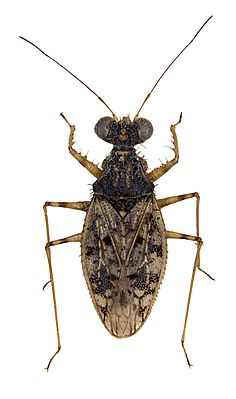Leptopus marmoratus
| Leptopus marmoratus | ||||||||||
|---|---|---|---|---|---|---|---|---|---|---|

Leptopus marmoratus , specimen from the Zoological State Collection in Munich |
||||||||||
| Systematics | ||||||||||
|
||||||||||
| Scientific name | ||||||||||
| Leptopus marmoratus | ||||||||||
| ( Goeze , 1778) |
Leptopus marmoratus is the only species of the bed bug family Leptopodidae that occurs in Germany and Austria.
features
The small species reaches a body length between 3.8 and 4.7 millimeters. The head, pronotum and scutellum are colored black with slight yellow markings. The corium on the half-ceilings is yellow-brown, the rest of the area gray, marbled with yellow-brown, whitish and black spots. The membrane of the half-ceilings is colored gray. The legs are light yellow-brown, the underside is colored black. As is typical of the relatives, the head is small with strikingly large, kidney-shaped complex eyes and two closely spaced ocelles on the forehead . The proboscis (rostrum) is very short. The head and the top of the half-ceilings as well as their outer edge and the forelegs are studded with spines. The legs are long and thin, the antennae long, thread-like and bare.
In Central Europe, the species is unmistakable as the only representative of its family. The striking thorns distinguish them from the similar bank bugs (family Saldidae).
distribution
The species lives in the Mediterranean area, including North Africa, and in southern and western Central Europe, in the east as far as Ukraine. The distribution limit goes right through Germany, it occurs north to the Middle Rhine Valley, the Elbe Valley in Saxony-Anhalt and the Oder Valley in Brandenburg. It is rare in Austria.
Leptopus marmoratus lives in dry, warm locations, always on and under stones. The habitats include stony river banks, scree slopes and quarries, but also stony limestone grasslands . The agile animals can run and fly quickly and hide on the underside of stones when they are startled, or they flee in flight. The Leptopus bugs can be active even at low temperatures. They live predatory, on small insects, probably mostly dust lice and their larvae. The spines on the front legs and on the rostrum probably have a function in catching prey.
Leptopus marmoratus overwinters as an adult bug. In warmer regions, as far as the Middle Rhine Valley, two generations can occur per year.
literature
- Ekkehard Wachmann, Albert Melber, Jürgen Deckert (2006): Bugs: Dipsocoromorpha, Nepomorpha, Gerromorpha, Leptopodomorpha, Cimicomorpha (Bugs, Volume 1). In Friedrich Dahl (founder): Die Tierwelt Deutschlands, Volume 77. Goecke & Evers Verlag, Keltern. ISBN 978-3-931374-49-5 . on pages 97 to 99.
- Eduard Wagner: Bugs or Heteroptera, Volume I. Pentatomorpha. In Friedrich Dahl (founder): The animal world of Germany and the adjacent parts of the sea, 54th part. Gustav Fischer Verlag, Jena 1966. on page 212.